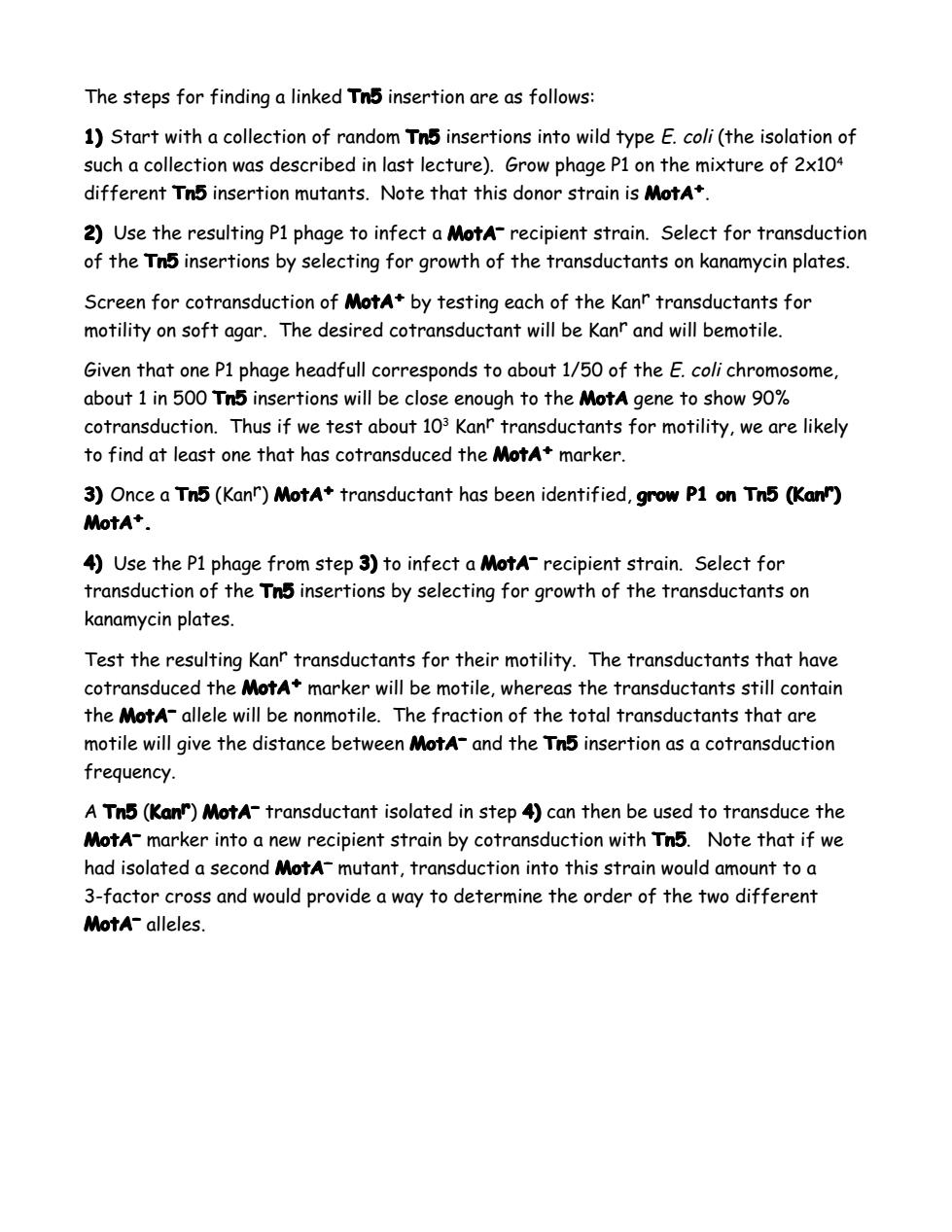正在加载图片...

The steps for finding a linked Tn5 insertion are as follows: 1)Start with a collection of random Tn5 insertions into wild type E.coli(the isolation of such a collection was described in last lecture).Grow phage P1 on the mixture of 2x104 different Tn5 insertion mutants.Note that this donor strain is MotA+. 2)Use the resulting P1 phage to infect a MotA-recipient strain.Select for transduction of the Tn5 insertions by selecting for growth of the transductants on kanamycin plates. Screen for cotransduction of MotA+by testing each of the Kanr transductants for motility on soft agar.The desired cotransductant will be Kanr and will bemotile Given that one P1 phage headfull corresponds to about 1/50 of the E.coli chromosome, about 1 in 500 Tn5 insertions will be close enough to the MotA gene to show 90% cotransduction.Thus if we test about 103 Kanr transductants for motility,we are likely to find at least one that has cotransduced the MotA*marker 3)Once a Tn5(Kanr)MotA+transductant has been identified,grow P1 on Tn5 (Kan) MotA+. 4)Use the P1 phage from step 3)to infect a MotA-recipient strain.Select for transduction of the Tn5 insertions by selecting for growth of the transductants on kanamycin plates. Test the resulting Kanr transductants for their motility.The transductants that have cotransduced the MotA+marker will be motile,whereas the transductants still contain the MotA-allele will be nonmotile.The fraction of the total transductants that are motile will give the distance between MotA-and the Tn5 insertion as a cotransduction frequency. A Tn5(Kan)MotA-transductant isolated in step 4)can then be used to transduce the MotA-marker into a new recipient strain by cotransduction with Tn5.Note that if we had isolated a second MotA-mutant,transduction into this strain would amount to a 3-factor cross and would provide a way to determine the order of the two different MotA-alleles.The steps for finding a linked Tn5 insertion are as follows: 1)Start with a collection of random Tn5 insertions into wild type E. coli (the isolation of such a collection was described in last lecture). Grow phage P1 on the mixture of 2x104 different Tn5 insertion mutants. Note that this donor strain is MotA+. 2) Use the resulting P1 phage to infect a MotA– recipient strain. Select for transduction of the Tn5 insertions by selecting for growth of the transductants on kanamycin plates. Screen for cotransduction of MotA+ by testing each of the Kanr transductants for motility on soft agar. The desired cotransductant will be Kanr and will bemotile. Given that one P1 phage headfull corresponds to about 1/50 of the E. coli chromosome, about 1 in 500 Tn5 insertions will be close enough to the MotA gene to show 90% cotransduction. Thus if we test about 103 Kanr transductants for motility, we are likely to find at least one that has cotransduced the MotA+ marker. 3)Once a Tn5 (Kanr) MotA+ transductant has been identified, grow P1 on Tn5 (Kanr) MotA+. 4) Use the P1 phage from step 3) to infect a MotA– recipient strain. Select for transduction of the Tn5 insertions by selecting for growth of the transductants on kanamycin plates. Test the resulting Kanr transductants for their motility. The transductants that have cotransduced the MotA+ marker will be motile, whereas the transductants still contain the MotA– allele will be nonmotile. The fraction of the total transductants that are motile will give the distance between MotA– and the Tn5 insertion as a cotransduction frequency. A Tn5 (Kanr) MotA– transductant isolated in step 4) can then be used to transduce the MotA– marker into a new recipient strain by cotransduction with Tn5. Note that if we had isolated a second MotA– mutant, transduction into this strain would amount to a 3-factor cross and would provide a way to determine the order of the two different MotA– alleles